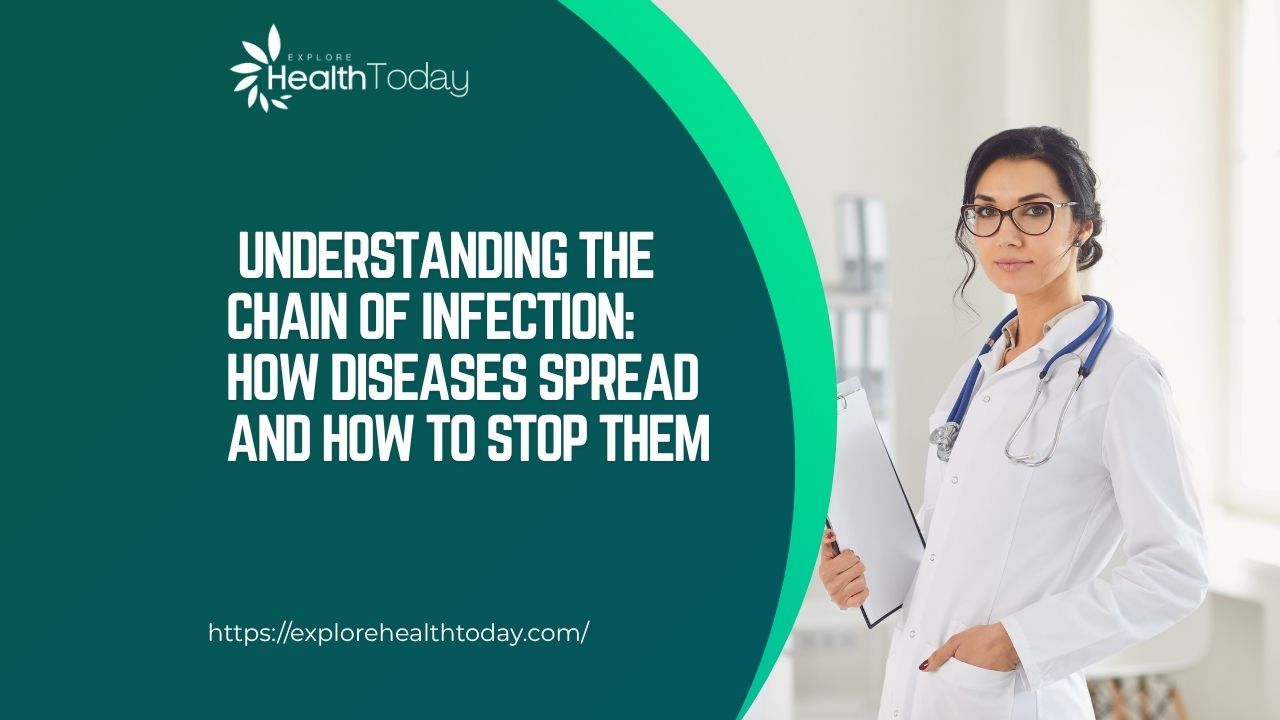Introduction: Why Understanding the Chain of Infection Matters More Than Ever
From the COVID-19 pandemic to the seasonal flu, Americans are more aware than ever that infections don’t just appear—they spread through predictable patterns. Whether you’re a healthcare professional, a parent, or someone interested in protecting your health, understanding the chain of infection is one of the most important tools you can have.
The chain of infection refers to the six steps through which infectious diseases are transmitted. Once you understand these steps, you can identify weak points and take preventive actions to break the chain. This isn’t just medical jargon—it’s a public health strategy that’s helped contain diseases for decades.
Let’s take a deep dive into how the chain of infection works, real-life examples from the U.S., and what you can do to protect yourself and your community.
What Is the Chain of Infection?
The chain of infection is a model used to understand how diseases spread from one person to another. It includes six key components:
- Infectious Agent – The pathogen (like bacteria, viruses, fungi, or parasites) that causes the disease.
- Reservoir – The place where the pathogen lives (people, animals, or surfaces).
- Portal of Exit – How the pathogen leaves the reservoir (through coughing, sneezing, or blood).
- Mode of Transmission – How it travels (airborne, direct contact, droplets, etc.).
- Portal of Entry – How it enters a new host (mouth, nose, broken skin).
- Susceptible Host – A person who can get sick because their immune system can’t fight it off.
If even one link in this chain is broken, the spread of infection can be stopped.
The Six Links in the Chain of Infection
1. Infectious Agent
This is the germ or pathogen responsible for the disease. In the U.S., common infectious agents include:
- Influenza virus (flu)
- SARS-CoV-2 (COVID-19)
- Staphylococcus aureus (MRSA)
- Norovirus (gastroenteritis outbreaks)
These microorganisms differ in virulence, resistance, and how easily they spread. The CDC constantly monitors new and emerging pathogens to track public health risks.
2. Reservoir
The reservoir is where the pathogen lives, multiplies, and survives. many cases, the reservoir is a human or animal host. In healthcare settings, surfaces, medical equipment, and water sources can also serve as reservoirs.
In the U.S., nursing homes and hospitals are especially vulnerable. According to the CDC, healthcare-associated infections (HAIs) are a serious concern, with nearly 1 in 31 hospital patients battling an HAI daily.
3. Portal of Exit
This is how the pathogen escapes its host. Examples include:
- Coughing or sneezing (releasing droplets)
- Feces or urine
- Open wounds or blood
- Vomiting
Understanding the portal of exit is key to setting up effective protective measures—like covering a cough or wearing gloves during wound care.
4. Mode of Transmission
The mode of transmission refers to how the pathogen gets from one person (or surface) to another. There are several types:
- Direct contact (touching an infected person)
- Indirect contact (touching contaminated objects)
- Droplet transmission (sneezing, coughing)
- Airborne transmission (tiny particles that stay suspended in the air)
- Vector-borne (like mosquitoes or ticks)
During the COVID-19 pandemic, the airborne and droplet routes became a major focus in the U.S., leading to changes in ventilation standards in public buildings.
5. Portal of Entry
The pathogen needs to enter the new host in a way that allows it to infect. Entry points include:
- Nose or mouth
- Eyes
- Broken skin
- Injections or surgical wounds
This is why proper hand hygiene and using personal protective equipment (PPE) are so important in hospitals and care homes.
6. Susceptible Host
Not everyone exposed to a germ will get sick. A susceptible host is someone whose immune system can’t effectively fight off the infection. Susceptibility increases with:
- Chronic illnesses (e.g., diabetes, cancer)
- Age (very young or elderly)
- Weakened immune systems
- Lack of vaccination
For example, in 2024, flu vaccination rates among U.S. adults aged 65+ reached nearly 70%, according to HHS, helping reduce complications from seasonal influenza.
Real-World Examples from the U.S.
COVID-19 Pandemic (2020–2024)
The global pandemic highlighted the importance of breaking the chain of infection. Key steps included:
- Vaccination to reduce susceptibility
- Mask mandates to block portals of exit and entry
- Social distancing to reduce modes of transmission
- Quarantine and isolation to eliminate reservoirs
Each of these measures targeted specific links in the chain and were critical in slowing the virus’s spread.
H3: MRSA in U.S. Hospitals
Methicillin-resistant Staphylococcus aureus (MRSA) remains a serious issue in American healthcare settings. Hospitals now emphasize:
- Handwashing protocols
- Sanitizing high-touch surfaces
- Screening patients for MRSA colonization
These infection control policies help disrupt transmission and reduce the number of susceptible hosts.
How to Break the Chain of Infection in Daily Life
You don’t have to be a healthcare worker to play a role in infection prevention. Small changes in everyday behavior can have a big impact.
Personal Tips:
- Wash your hands regularly with soap and water for at least 20 seconds.
- Stay home when you’re sick to avoid spreading germs.
- Cover your mouth and nose when sneezing or coughing.
- Avoid touching your face, especially your mouth, nose, and eyes.
- Keep surfaces clean, especially in high-traffic areas like kitchens and bathrooms.
In Healthcare Settings:
- Use PPE correctly—gloves, masks, gowns, and face shields.
- Disinfect equipment and surfaces between patients.
- Ensure staff are trained in infection control protocols.
- Administer and encourage vaccinations for preventable diseases.
For more evidence-based prevention strategies, visit the World Health Organization.
U.S. Policies and Public Health Trends (2024–2025)
As of 2025, the U.S. is placing a stronger emphasis on infection control with several new initiatives:
- Updated infection control training required in all federally funded healthcare facilities.
- Increased funding for CDC’s Antibiotic Resistance Solutions Initiative, combating superbugs like MRSA and C. diff.
- Expansion of school-based health programs that teach students about hygiene and disease prevention early on.
These policies aim to protect vulnerable groups and reinforce the importance of breaking the chain of infection at a national level.
Conclusion: Awareness is the First Step to Prevention
The chain of infection isn’t just a concept from textbooks—it’s a practical framework for keeping communities safe from disease. When we understand how each link works, we can make smarter decisions in our homes, schools, hospitals, and workplaces.
Whether you’re teaching your kids proper handwashing, ensuring vaccinations are up to date, or advocating for safer work conditions, breaking the chain of infection starts with awareness.
Want to take control of your health and help stop the spread of infectious diseases? Start by learning how each part of the chain of infection works—and then take action to break the links in your daily life. Visit CDC.gov for trusted guidance, or check out your state health department for local resources.
About ExploreHealthToday.com
ExploreHealthToday.com was created to be a one-stop resource where readers can find up-to-date, well-researched articles on a variety of health topics. From nutrition and wellness to lifestyle and mental health, we strive to provide reliable information to help you make informed decisions about your well-being.
We believe that good health starts with good information, and our mission is to empower our readers with knowledge they can trust.
Visit us at ExploreHealthToday.com to learn more.





